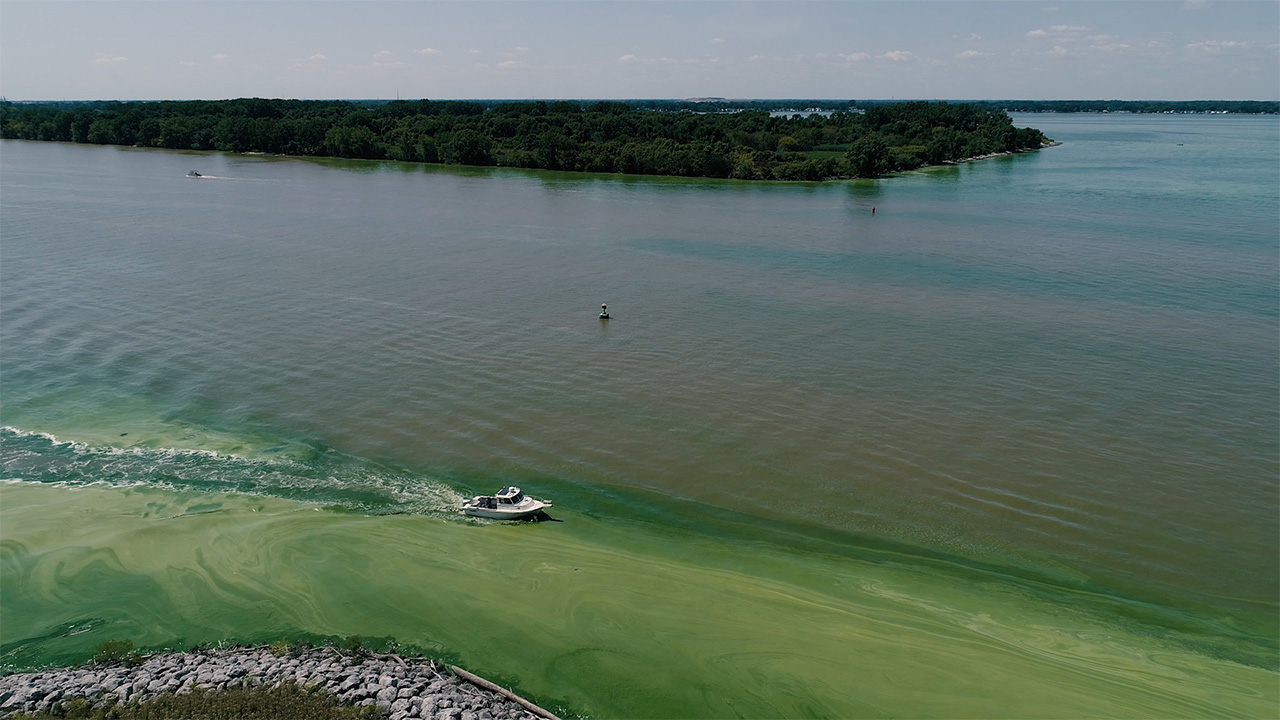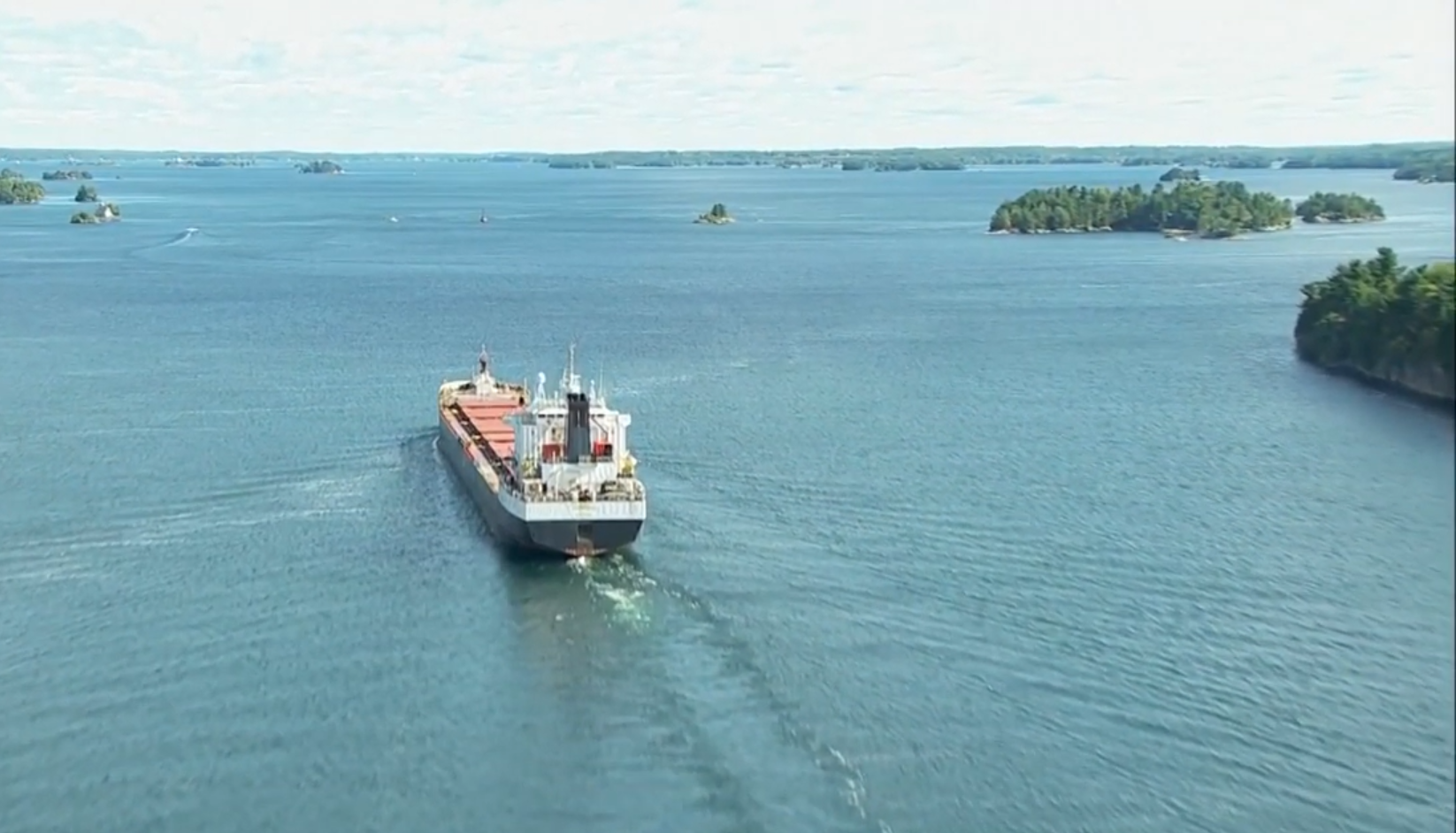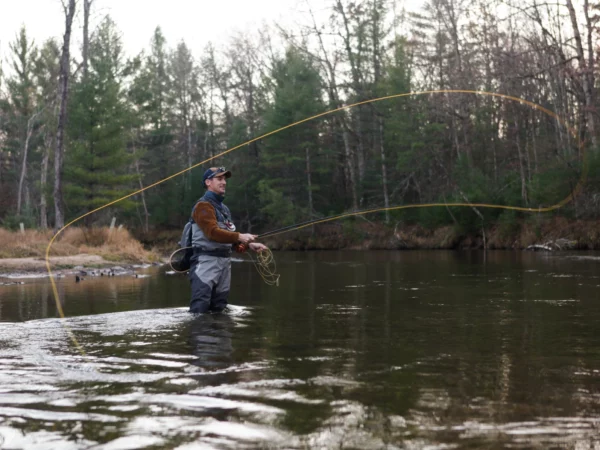
As algal blooms flourish on the edges of the Great Lakes, lake management bodies look to cut down the flow of nutrients into the water that feeds the algae. But, as a recent report by the International Joint Commission explains, not all parts of the lakes suffer from too many nutrients — in fact, the deeper offshore waters aren’t getting enough.
The International Joint Commission is a scientific organization that helps the governments of Canada and the United States uphold their agreement to make sure the Great Lakes are swimmable, drinkable and fishable.
In late June, the Commission’s Science Advisory Board released a report on the decline in nutrients in the offshore waters of the lakes and the harmful impact this decline is having on fish populations.
Phosphorus is an essential nutrient that fuels life in the Great Lakes ecosystems. The amount of phosphorus determines how many living things can survive in the lake, from tiny plankton up to top predator fish. And in every lake except Erie, the phosphorus levels in the offshore region — waters more than twenty meters deep — are below the targets established under the Great Lakes Water Quality Agreement between the United States and Canada.
“Nutrients in and of themselves are essential,” said Marc Gaden, communications director and legislative liaison at the Great Lakes Fishery Commission. “Too much of a good thing manifests itself as the harmful algal blooms we’re seeing in places like Lake Erie. But there is another question — could you go too far on nutrient reduction? Fish need nutrients, so if you curb nutrient inputs, are you starving fish in the lakes? And this report is the first one I know that really addresses that topic.”
API key not valid. Please pass a valid API key.Invasive mussels divide the lakes
The history of nutrient targets in the Great Lakes goes back to 1972, when the United States and Canada first set limits for how much phosphorus could flow into each lake in the Great Lakes Water Quality Agreement.
“In order to control algal growth, back in the 1970s we established phosphorus load reductions for all of the lakes,” Joseph DePinto, one of the primary authors of the IJC report, explained. “And those phosphorus load targets were achieved in the 1980s — it was a great success.”
But although the nutrient controls were initially successful, in the late 1980s and early 1990s invasive mussels moved into the Great Lakes and disrupted that newly created balance.
Zebra and quagga mussels are filter feeders that have clarified water in the nearshore areas of the Great Lakes. The increased clarity and filtering traps phosphorus coming into the lakes in the nearshore environments, preventing it from getting into deeper waters as much as it had before the mussel invasion.
The mussels created the divide we see today between nearshore and offshore areas of the Great Lakes — the nearshore areas struggle with excessive blooms of blue-green algae and large growths of Cladophora, a type of attached algae, while in the offshore areas there aren’t enough nutrients to support thriving fisheries.
“The phosphorus loads — what’s coming into the lakes — have not changed from 1990 to now,” DePinto said. “However, the concentrations in the water have gone up in the nearshore and down in the offshore, relative to what they were before mussels came in.”
API key not valid. Please pass a valid API key.Studying the problem
One of the tasks of the IJC Science Advisory Board is to identify standing issues and bring them to the attention of the commissioners on the IJC, and Robert Hecky brought forward concerns about trends among fishery management agencies in the region.
“What was worrying was that the prey fish, which those top predators consume, were in general decline across the lakes, and what was causing that was not clear,” Hecky said. “These trends were ongoing over many years, but at some point they were beginning to affect the top predators in terms of their availability and growth.”
Hecky and DePinto, also a member of the IJC Science Advisory Board, were appointed co-chairs of a work group to investigate the drop in prey fish in these offshore areas. They put together a team of scientists from different disciplines across the region to take a whole ecosystem look at what’s causing this phenomenon.
The report acknowledges that it is difficult to find a clear relationship between the amount of predator fish and the amount of nutrients in the lakes because of many complicating factors, including stocking issues, harvesting, climate and spawning habitat. But the team found a clear relationship between the forage fish — the smaller fish that are eaten by the larger fish — and nutrient levels.
Lower phosphorus levels lead to lower zooplankton growth in the lakes. Zooplankton is the food for the prey fish, which are in turn food for larger fish like lake trout and salmon.
“The theory is that everything else being equal, if you have less phosphorus in the offshore waters, you’ll have lower production of the top predator fish,” DePinto said. “And we’re seeing evidence at least up through the forage fish level.”

Harmful algal bloom in western Lake Erie (Great Lakes Now Episode 1013)
Differences between lakes
The significance of the nearshore-offshore divide also varies from lake to lake. Lake Erie is the only lake where there are no concerns about low offshore productivity — the focus remains on cutting back on phosphorus to stop algal blooms.
Lake Huron and Lake Michigan, on the other hand, are dealing with the most damage to their fish populations from these low nutrient levels. In these lakes, the fisheries have noticed a decline in the prey fish populations — enough to impact how much predator fish they can stock in the lakes.
“Lake Huron was the earliest lake to show these kinds of trends and changes in the fish community and Lake Michigan is following that path,” Hecky said.
Lake Superior’s data suggests that declining nutrients in the offshore could be a problem, but the issue is not as bad as in the other two lakes.
“There’s evidence of decline in phosphorus in Superior. The actual data from the EPA and Environment Canada are not in complete agreement on offshore concentrations — we pointed that out in the report,” Hecky said. “Independent of trends in phosphorus, there are some suggestions that prey fish productivity is declining, but not nearly as strong as in Michigan and Huron.”
Spotlight is now on Lake Ontario
In the last couple decades, the sharp decline in phosphorus levels has leveled off in most of the lakes. Phosphorus concentrations have “more or less plateaued,” at the current lower concentrations, Hecky said.
But it may not stay that way for long. Partly prompted by concerns about algal growth in the nearshore, the 2012 Great Lakes Protocol for the Water Quality Agreement formed an Annex 4 subcommittee to review the nutrient targets for all of the lakes.
New targets have already been set for Lake Erie — a 40 percent reduction in phosphorus loading for the eastern and central basins of the lake.
Eyes are now on Lake Ontario. The Annex 4 subcommittee is actively reviewing the lake’s nutrient targets, and the authors of this IJC report are urging committee members to take offshore nutrient concentrations into consideration when making any decisions.

A freighter crosses Lake Ontario. (Great Lakes Now Episode 1005)
The recently reduced nutrient load in Lake Erie will have consequences for downstream Ontario, which receives between 35-40% of its nutrient load from Erie. And if Lake Ontario’s own nutrient load is also cut back, the offshore phosphorus levels could be plunged back into sharp decline.
“We’re calling on the parties to be aware that we’re at this equilibrium of very low levels of phosphorus,” Hecky said. “The productivity of the biological communities is already low.”
While Lake Ontario is not struggling as much as Lake Huron and Lake Michigan yet, an observed decline in the lake’s prey fish is a warning sign.
“The salmon fishery, which is the most economically important fishery on the lake, is still in relatively good condition,” Hecky said. “But the concern is that changes we’ve seen in Huron and Michigan may occur in Ontario and we want to be aware of those changes as early as we can.”
But leaving the nutrient targets alone is likely not an option — excess nutrients collecting in the nearshore are still an issue for the lake.
“The problem is that to address the blue-green blooms in the nearshore, we would need to reduce phosphorus loadings even more than what they already are,” DePinto said. “On the other hand, the effect of that is we make the offshore production even lower than what it already is. So we have this conundrum that we’re dealing with.”
Looking at the big picture
Tackling this conundrum will require a whole ecosystem approach to managing the Great Lakes, and that means bridging the gap between areas of lake management that have typically worked independently.
“This report is a major connection between the people who traditionally work in water quality and people who work in fisheries or in other parts of the ecosystem,” Gaden said. “To get the perspective of fishery managers on nutrient loadings into the Great Lakes represents an evolution and an improvement in our collective work to manage the Great Lakes and understand what’s going on out there.”
According to Gaden, the separation between water quality and fisheries management has been slowly breaking down. The latest version of the Great Lakes Water Quality Agreement in 2012, for example, took a more ecosystem-based approach than previous versions of the agreement. This recent IJC report continues this process by calling on the Great Lakes Executive Committee to form a multiagency Cooperative Ecosystem Monitoring and Modeling Advisory Committee to work with state and provincial fisheries and environmental agencies, as well as other national and binational monitoring and management agencies.
“What we’re proposing with this report is to form a committee that gets the water quality managers talking to the fisheries managers to get a full picture of the lake ecosystems and how they’re functioning,” DePinto said.
The report also emphasizes the need to create and use new mathematical models that include all parts of the ecosystem — from the nutrient building blocks up through the top predator fish.
“Those models do not yet exist, or at least are not in practice on the Great Lakes yet,” Hecky said. “There are some very interesting initiatives in this direction, particularly in the Great Lakes Fishery Commission. So there’s progress coming, but we’re still in early days on this. And we’re calling for collaboration with the fishery commission in trying to develop and to validate these models.”
DePinto and Hecky are urging lake management to continue to study the relationship between nutrients and the higher levels of the food web. Before any further changes are made to phosphorus load reductions in the lakes, they believe it’s important to understand these connections and their implications more thoroughly.
“My great hope for the report is that it really does stimulate a full ecosystem approach to managing the lakes,” Hecky said. “I hope that people look at the lakes with new eyes and new appreciation about how they are being challenged by changes that are ongoing. Lakes have long memories, but they also have long futures, and we have to be looking to the future as well as the past.”
Read more stories on Great Lakes fish populations on Great Lakes Now:
Michigan officials investigate fish kill on Escanaba River
Number of fish types in Chicago waters up to nearly 60 from about 10
Multi-million dollar grant funds study of Great Lakes aquaculture
Yellow Perch, Emerald Shiners: Diet change might have led to drop in fish catches
Featured image: Toxic algae blooms around the Great Lakes in the summer. (Great Lakes Now Episode 1013)
1 Comment
-
Great article! Does anyone have a quantitative estimate for the amount of phosphorus in Lake Erie currently? I am doing a project for school and I can’t seem to find any current (2020) data on nutrient abundance. Would be greatly appreciated!




